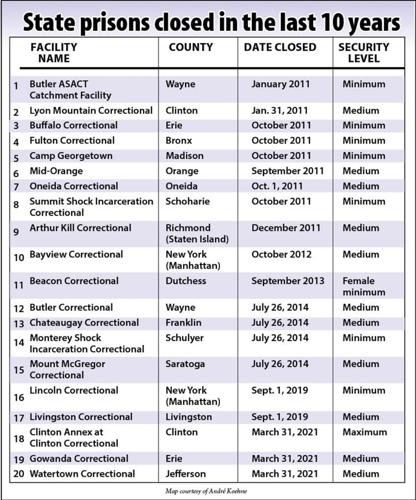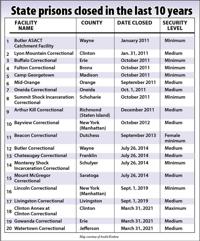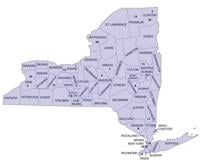State officials are expected to announce the closure of multiple state prisons in the coming days with the goal to shutter more facilities by Labor Day.
It is unclear how many prisons, or which ones, are expected to be closed by summer’s end.
Language in the Legislature’s adopted 2021-22 state budget permits Gov. Andrew Cuomo to permanently close facilities with a 90-day notice through the end of March 2022. The state Department of Corrections and Community Supervision must notify prison administrators and staff of its decisions by June 6 to finalize a permanent closure by Labor Day, or Monday, Sept. 6.
Officials with the state Correctional Officers & Police Benevolent Association, the union that represents New York’s 18,000 correction officers, said the agency and prison staff are kept in the dark about closures often until the day of the announcement.
“Unfortunately, there hasn’t been any significant dialogue between DOCCS and NYSCOPBA regarding these impending prison closures,” NYSCOPBA President Michael Powers said in a statement. “Based on Commissioner’s budget testimony in February 2021, we anticipate additional facility closures in this fiscal year and next. At this point, anything further than that is speculation.”
NYSCOPBA leaders and prison staff have not been consulted by the state Department of Corrections and Community Supervision or Gov. Andrew Cuomo’s administration in the Executive Chamber to evaluate which facilities to close.
Fourteen of the 20 state prisons and correction facilities closed over the last decade, have taken place upstate, or north of Dutchess County.
“Unfortunately we have not been involved in those discussions,” Powers said. “Based on where the remaining facilities reside, we anticipate that a majority of additional closures will also impact upstate communities.”
Union leaders and prison administrators are anticipating and preparing for the announcement.
Previous closures have been announced by DOCCS officials or the governor’s office.
“We haven’t been provided with a specific timeframe on closures,” Powers said. “Our members typically find out at the same time the public does.”
The Legislature’s 2021-22 adopted budget allows the governor to circumvent state Correction Law Section 79-a — signed into law in 2005 — which requires officials announce a prison closure at least 12 months in advance.
“The enacted Fiscal Year 2021-22 New York State budget authorizes the governor to continue to close facilities as is safe and fiscally appropriate, and it was voted on and approved by the Legislature,” according to a statement from state Department of Corrections and Community Supervision. “DOCCS is carefully reviewing the operations at its 50 correctional facilities for possible closure. This review is based on a variety of factors, including but not limited to physical infrastructure, program offerings, facility security level, specialized medical and mental health services, other facilities in the area to minimize the impact to staff, potential reuse options and areas of the state where prior closures have occurred in order to minimize the impact to communities.”
No layoffs of corrections officers and prison staff are expected with the anticipated additional closures, according to the department. Employees will receive priority placement to transfer to work in other undetermined state facilities.
“As past closures have shown, DOCCS works closely with the various bargaining units to provide staff opportunities for priority placement via voluntary transfers and will receive priority in terms of employment at other facilities or other state agencies as a result of the formal Civil Service process that is followed with the closure of a correctional facility,” according to the department. “DOCCS does not anticipate any layoffs due to these closures.”
The March 31 closing of Watertown Correctional Facility, Gowanda Correctional Facility in Erie County and the Clinton Annex at Clinton Correctional Facility in Dannemora, were announced four days before Christmas 2020. Clinton Correctional Facility, a maximum-security prison, remains open.
Hundreds of impacted employees were each offered a transfer or be reassigned to an available, funded, vacant position at another correctional facility or state agency.
The three facilities had about 700 total incarcerated individuals at the time of the closure announcement.
Since, corrections officers, prison staff and lawmakers representing communities where the prisons are located have pushed back against more accelerated closings. The shortened three-month time frame — nine months fewer than required by state Correction Law — creates additional hardship on all staff and job loss for local communities, Powers said.
“They are uprooted, transferred to another facility, potentially hundreds of miles away, and it potentially creates a tremendous strain on their families,” he said. “All within a 90-day window, which seems unreasonable to expect someone to successfully uproot their family, find new housing, enroll children in a new school district, all while continuing to do their job. Compound that with the current COVID pandemic and it’s just mean-spirited. Not to mention the devastating economic impact it has on those small rural communities where the facilities are located. Rushing these facility closures during a pandemic is short-sighted and nonsensical.”
Twenty New York prisons and correctional facilities have closed in the last 10 years, with 19 directed by Gov. Andrew Cuomo. The closure of Lyons Correctional Facility in Clinton County was directed by former Gov. David Paterson, who left office at the end of 2010.
Twenty-three facilities have closed since 2009 — targeting upstate and minimum- and medium-security prisons.
“As long as you have prisons, they’re going to find a way to put bodies in there... there’s a demand for bodies to be in them,” said Jose Hamza Saldaña, director of the Releasing Aging People in Prison campaign. “We have prisons just so people can be gainfully employed on the backs of Black and Latinx people — that’s what it really boils down to. They’re not filling up these prisons with white people from the rural areas, they’re filling them from the urban communities and communities of New York City.
“...the economy of upstate New York is not more important than the sub-economy of the ghettos of New York City, and that, to me, is just a racist approach to addressing economic conditions.”
Saldaña, who was incarcerated in prisons statewide from the city to the North Country for 38 years, said with thousands fewer incarcerated New Yorkers, fewer prisons is the only action that makes sense.
The state’s incarcerated population is at its lowest level in 37 years, according to DOCCS. The total incarcerated population in state correctional facilities was 31,417 people as of April 30 — a reduction of more than 24,560 people, or 44%, since Cuomo took office Jan. 1, 2011, when New York’s prison population totaled 55,979.
“Facilities, all the way from Clinton to Chenango correctional — it’s a family occupation,” Saldaña recalled of his time in state prisons. “You see brothers, cousins, fathers and uncles all working in this prison system.”
Saldaña pushed for the need for state leaders to focus on criminal justice reform to release aging people from prison and reform the state’s parole system to further decarcerate New York prisons. He encouraged New Yorkers to think differently about punishment and programs to help incarcerated people.
“Everything should not be dealt with punishment — there are some things that should be dealt with in a manner that develops positive and beneficial relationships with people,” Saldaña said. “If [more prisons] were the answer, we would be in a safe society ... and we’re far from being in a safe society. If it’s never worked, why continue with that form of addressing everything?
“...In spite of all the brutality and all the dehumanizing and segregation and abuse that goes on in prison, men and women have actually transformed their lives and helped others transform their lives.”
DOCCS will work with the Office of General Services and Economic Development to facilitate the re-use of additional prison facilities to be closed this year.
“Upon closure, DOCCS will begin the decommission process in order to protect the state assets for potential re-use,” according to the department.
Powers pushed for the governor’s office and DOCCS to abide by state law and give staff at least a one-year notification before a facility is shuttered.
“Ninety days simply isn’t enough time,” he said, adding assaults on correction staff have doubled in the past decade.
The number of assault on DOCCS staff and related incidents remained flat in 2019 and 2020, according to the department.
Assaults on staff have increased from 760 in 2016 to 1051 in 2020, according to the state Correctional Officers & Police Benevolent Association. The inmate population in 2016 was 52,262, and dipped to 34,669 in 2020.
During a bicameral legislative budget hearing Feb. 10, DOCCS Acting Commissioner Anthony Annucci said closing facilities has no correlation with the increased incidents of violence and assaults on corrections officers.
Powers urged the Legislature to create a commission to study the reason for the increased violence in the prison population and against correction officers, and the impact of the attacks in facilities.
“With assaults on staff increased by 100 percent over the past decade, and the prison population reduced by over 20,000 inmates in that time period, any additional closures should be halted until a comprehensive study can be conducted,” Powers said. “In addition, as we navigate through COVID, there is still a need to create social distancing inside facilities to protect staff and inmates. Closures will only create less available space within our facilities and severely limit the ability to keep staff and inmates safe from contracting the virus.”
DOCCS reports 1,047 incidents in 2020 where an incarcerated person assaulted a correction officer with just under 34,500 New Yorkers imprisoned statewide last year, up from 524 assaults on staff in 2012 when the incarcerated population totaled 64,865 people.
DOCCS representatives would not answer how many facilities will be shuttered and where, how much money will be saved in closing the additional prisons, how many incarcerated people will need to be relocated, the number of prison staff to be affected and the cost to transfer incarcerated people to other facilities.
The state estimates the March closure of the Watertown and Gowanda facilities and Clinton Annex will save $89 million.
Representatives from Gov. Andrew Cuomo’s office referred all questions about the upcoming and fast-tracked prison closures to DOCCS’ statement, and would not answer questions about which facilities will be closed or the reason for including language in the budget to accelerate facility closures for this fiscal year ending March 2022.
The governor’s initial budget released in January proposed allowing for a 90-day notification to close prisons in the state for the next two fiscal years, or through the end of March 2023.















